Survey of chimeric IStron elements in bacterial genomes: multiple molecular symbioses between group I intron ribozymes and DNA transposons
- PMID: 25324310
- PMCID: PMC4227781
- DOI: 10.1093/nar/gku939
Survey of chimeric IStron elements in bacterial genomes: multiple molecular symbioses between group I intron ribozymes and DNA transposons
Abstract
IStrons are chimeric genetic elements composed of a group I intron associated with an insertion sequence (IS). The group I intron is a catalytic RNA providing the IStron with self-splicing ability, which renders IStron insertions harmless to the host genome. The IS element is a DNA transposon conferring mobility, and thus allowing the IStron to spread in genomes. IStrons are therefore a striking example of a molecular symbiosis between unrelated genetic elements endowed with different functions. In this study, we have conducted the first comprehensive survey of IStrons in sequenced genomes that provides insights into the distribution, diversity, origin and evolution of IStrons. We show that IStrons have a restricted phylogenetic distribution limited to two bacterial phyla, the Firmicutes and the Fusobacteria. Nevertheless, diverse IStrons representing two major groups targeting different insertion site motifs were identified. This taken with the finding that while the intron components of all IStrons belong to the same structural class, they are fused to different IS families, indicates that multiple intron-IS symbioses have occurred during evolution. In addition, introns and IS elements related to those that were at the origin of IStrons were also identified.
© The Author(s) 2014. Published by Oxford University Press on behalf of Nucleic Acids Research.
Figures
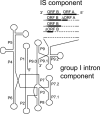


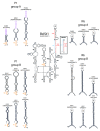
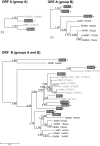

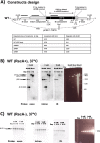
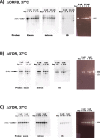
Similar articles
-
Clostridium difficile IStron CdISt1: discovery of a variant encoding two complete transposase-like proteins.J Bacteriol. 2004 Apr;186(8):2508-10. doi: 10.1128/JB.186.8.2508-2510.2004. J Bacteriol. 2004. PMID: 15060058 Free PMC article.
-
Bacterial group II introns generate genetic diversity by circularization and trans-splicing from a population of intron-invaded mRNAs.PLoS Genet. 2018 Nov 21;14(11):e1007792. doi: 10.1371/journal.pgen.1007792. eCollection 2018 Nov. PLoS Genet. 2018. PMID: 30462638 Free PMC article.
-
Remarkable abundance and evolution of mobile group II introns in Wolbachia bacterial endosymbionts.Mol Biol Evol. 2011 Jan;28(1):685-97. doi: 10.1093/molbev/msq238. Epub 2010 Sep 6. Mol Biol Evol. 2011. PMID: 20819906
-
Insights into the strategies used by related group II introns to adapt successfully for the colonisation of a bacterial genome.RNA Biol. 2014;11(8):1061-71. doi: 10.4161/rna.32092. Epub 2014 Oct 31. RNA Biol. 2014. PMID: 25482895 Free PMC article. Review.
-
Mobile group II introns.Annu Rev Genet. 2004;38:1-35. doi: 10.1146/annurev.genet.38.072902.091600. Annu Rev Genet. 2004. PMID: 15568970 Review.
Cited by
-
Are viruses alive? The replicator paradigm sheds decisive light on an old but misguided question.Stud Hist Philos Biol Biomed Sci. 2016 Oct;59:125-34. doi: 10.1016/j.shpsc.2016.02.016. Epub 2016 Mar 7. Stud Hist Philos Biol Biomed Sci. 2016. PMID: 26965225 Free PMC article.
-
Transposon-encoded nucleases use guide RNAs to promote their selfish spread.Nature. 2023 Oct;622(7984):863-871. doi: 10.1038/s41586-023-06597-1. Epub 2023 Sep 27. Nature. 2023. PMID: 37758954 Free PMC article.
-
Transposon-encoded nucleases use guide RNAs to selfishly bias their inheritance.bioRxiv [Preprint]. 2023 Mar 29:2023.03.14.532601. doi: 10.1101/2023.03.14.532601. bioRxiv. 2023. Update in: Nature. 2023 Oct;622(7984):863-871. doi: 10.1038/s41586-023-06597-1. PMID: 36993599 Free PMC article. Updated. Preprint.
-
Single-Cell (Meta-)Genomics of a Dimorphic Candidatus Thiomargarita nelsonii Reveals Genomic Plasticity.Front Microbiol. 2016 May 3;7:603. doi: 10.3389/fmicb.2016.00603. eCollection 2016. Front Microbiol. 2016. PMID: 27199933 Free PMC article.
-
Antagonistic conflict between transposon-encoded introns and guide RNAs.Science. 2024 Jul 12;385(6705):eadm8189. doi: 10.1126/science.adm8189. Epub 2024 Jul 12. Science. 2024. PMID: 38991068 Free PMC article.
References
-
- Frost L.S., Leplae R., Summers A.O., Toussaint A. Mobile genetic elements: the agents of open source evolution. Nat. Rev. 2005;3:722–732. - PubMed
-
- Hazen T.H., Pan L., Gu J.D., Sobecky P.A. The contribution of mobile genetic elements to the evolution and ecology of Vibrios. FEMS Microbiol. Ecol. 2010;74:485–499. - PubMed
-
- Kazazian H.H., Jr Mobile elements: drivers of genome evolution. Science. 2004;303:1626–1632. - PubMed
-
- Lisch D. How important are transposons for plant evolution. Nat. Rev. Genet. 2013;14:49–61. - PubMed
Publication types
MeSH terms
Substances
LinkOut - more resources
Full Text Sources
Other Literature Sources
Molecular Biology Databases

